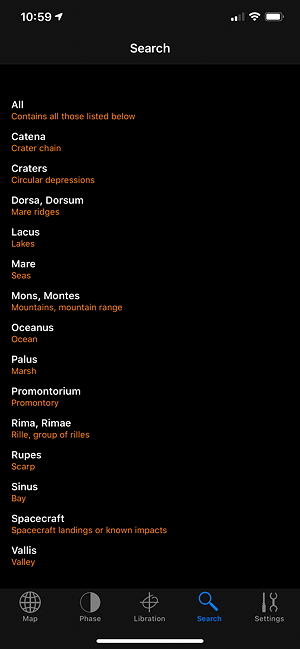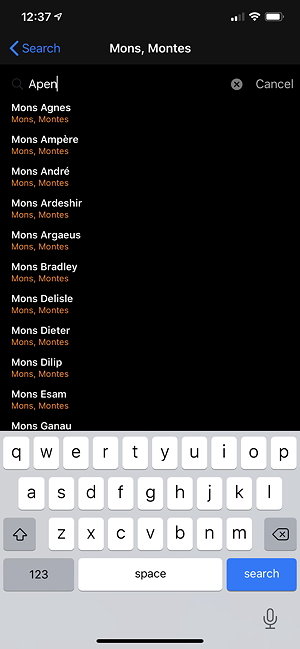Review - Moon Atlas for iOS
Posted: 3 May 2020
![]()
Moon Atlas
Julian James
$5.99
I have been using a free Moon atlas program on my iPhone for a long time. While that app worked fine for what it did, I wanted something more: an accurate representation of the extent and location of lunar libration, which allows us to see about 59% of the Moon's surface over time. The only iOS app I found that could do that was Moon Atlas. I purchased Moon Atlas for iOS.
When the app is launched you see this display.

You should first go to the Settings and change your location. Tapping "Find me" will fail with the alert shown.


Once you give the app permission to access your location, Find me will work. You should also change the other settings as appropriate. I enabled "Realtime update". While on Settings you should review the brief Help page to learn how to adjust what Moon Atlas shows.


On the Map display you can change how to display the Moon. Tapping the A button at the bottom left will turn ON/OFF labels and Lat/Long lines. Tapping N at the bottom right will change the orientation of the Moon to match the view in your eyepiece. Tapping the Phase button at the upper right will toggle showing the Moon's phase ON or OFF. Tapping the Earth button at the upper left will switch between the view from the Earth to a Globe display that can be rotated to show far side features.





The display can been zoomed in and out using two-finger gestures. The resolution of the zoomed-in display of the Moon is not the greatest and looks like viewing the Moon at high magnification on a night of poor seeing. Double-tapping on a feature label will show some information about that feature. Not all lunar features are identified so smaller features are unlabeled.


These views are all very useful. Unfortunately, the app does not remember the display modes set by the user when totally quitting the app. I have requested that this be added by the developer in a future update.
The Phase display will show the Moon's current phase and some information. Sliding the display left and right will display future and past phases by 24 hours. The Libration display shows the amount of libration visible along the lunar limb on each date in the displayed month.


I initially had a problem with the Libration display. Even with Realtime update OFF, swiping to show the next month briefly showed the next month and then quickly reverted back to the current month. Fortunately, the Map view of the Moon does show libration effects when you manually change the date. On subsequent launches of the app the Libration display worked properly. I reported this to the developer.
You can search for many types of features on the lunar surface, including spacecraft.



Although it is not obvious on the black display, you can enter text in a search field at the top of the screen. When you are viewing one of the Search categories there is a faint (hard to see) Cancel button at the top right. If you click to the left of the Cancel button you can enter text to search for. That should probably be noted in the Help.


The iPad version operates the same as the iPhone version with some user interface changes. The buttons at the bottom in the iPhone version are at the top in the iPad version. Help is immediately accessible using the "i" button at the top. And the Search feature is more obvious on the iPad at the top left.




Unlike the iPhone version, which only uses portrait mode, the iPad version can display in both portrait and landscape.
How well did Moon Atlas show what I was seeing at the telescope? Here's a view of the Moon through my 12" telescope (taken with an iPhone afocal 81X, 102X, and 163X, respectively) and the corresponding map display from Moon Atlas at the same time.






The actual lunar features, phase, and libration match the Moon Atlas display pretty accurately.
Summary
If you are a dedicated observer of our Moon and want to watch for "bonus" sights from libration, Moon Atlas is worth having. Accurately showing the current illumination (phase) at the time of your observing is useful to let you know if some lunar feature along the terminator is visible.
Moon Atlas can be used as a planning tool for lunar observations, although there are some limitations. Scrolling through months to show libration amounts is very helpful for planning. However, phase scrolling is only by 24 hours from the current time, which limits the app's usefulness as a planning tool. It is not possible to see what feature will be visible along the terminator at a specific date and time when you plan to do your lunar observing. It would be nice to be able to set the phase scroll time period (day, hour, minute) or set a specific date and time (past and future).
The only real drawback in Moon Atlas is the use of a low resolution image source. This can make identifying small lunar features at high eyepiece magnification difficult. However, I still expect to use Moon Atlas frequently when doing lunar observing at my telescope.
The developer also has a Moon Atlas app for the Macintosh, along with several planet atlas apps for both iOS and Macintosh.
Comments are welcome using Email. If you are on Twitter you can use the button below to tweet this review to your followers. Thanks.
Cassiopeia Observatory Home Page
Copyright ©2020 Michael L. Weasner / mweasner@me.com
URL = http://www.weasner.com/co/Reviews/2020/Moon_Atlas_iOS/index.html

